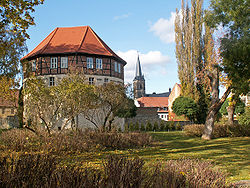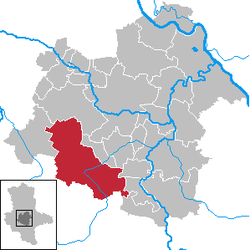Aschersleben
| Aschersleben | ||
|---|---|---|

View from Rondell to St.Stephan Church
|
||
|
||
| Coordinates: 51°45′N 11°28′E / 51.750°N 11.467°ECoordinates: 51°45′N 11°28′E / 51.750°N 11.467°E | ||
| Country | Germany | |
| State | Saxony-Anhalt | |
| District | Salzlandkreis | |
| Government | ||
| • Mayor | Andreas Michelmann (WIDAB) | |
| Area | ||
| • Total | 156.31 km2 (60.35 sq mi) | |
| Elevation | 114 m (374 ft) | |
| Population (2015-12-31) | ||
| • Total | 27,793 | |
| • Density | 180/km2 (460/sq mi) | |
| Time zone | CET/CEST (UTC+1/+2) | |
| Postal codes | 06449 | |
| Dialling codes | 03473 | |
| Vehicle registration | SLK, ASL, BBG, SBK, SFT | |
| Website |
www |
|
Aschersleben (German pronunciation: [ˈaʃɐsleːbən]) is a town in the Salzlandkreis district, in Saxony-Anhalt, Germany. It is situated approximately 22 km east of Quedlinburg, and 45 km northwest of Halle (Saale).
Aschersleben was first mentioned in 753, making it the oldest town of Saxony-Anhalt. The Latin name of the town's castle, Ascharia, provided the name of the House of Ascania. From 1252–1315 Aschersleben was the capital of Anhalt-Aschersleben, after which it passed to the Bishopric of Halberstadt. After the 1648 Peace of Westphalia, it became part of the Principality of Halberstadt. Aschersleben became part of the Prussian Province of Saxony in 1815.
A Junkers serial fuselage production facility was located in Aschersleben during the time of Nazi Germany. In April 1935 tools were transferred to Aschersleben, and by May 1935 the first fuselages were built there. The facility was located in the Wilslebener Strasse 9 near the so-called Seewiesen, where an airfield was erected as well. The Aschersleben shop area reached 564,000 square metres and about 6,000 people were employed at it.
During World War II, a subcamp of the Buchenwald concentration camp was located in the town. It was established to provide slave labour for Junkers (aircraft) and Motorenwerk (automotive).
...
Wikipedia



